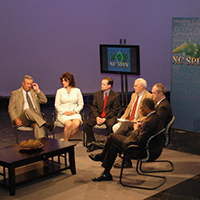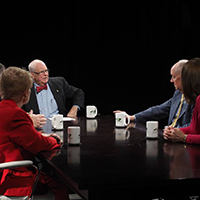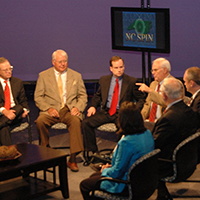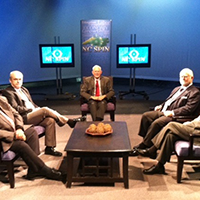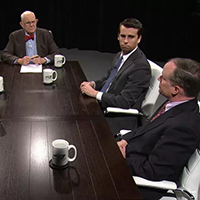UNC System at risk
Published December 11, 2015
by Sarah Ovaska-Few, NC Policy Watch, December 11, 2015.
The tumultuous political changes that have swept over North Carolina this decade have not spared the state’s public universities.
The 17-campus UNC system stands out nationally, especially in the South, for its quality, affordability and independence. It boasts the nation’s first public university; the prestigious N.C. School of Science and Mathematics for the state’s brightest high school students; more public historically black colleges than any other state; and campuses that routinely produce groundbreaking research.
In a 1994 book, historian John Egerton described the flagship university in Chapel Hill as “the single most glowing exception to broad-based mediocrity in the Southern academic world” for much of the 20th century.
Concern is growing in many quarters of the state, however, that years of budget cuts and a growing threat of political interference are placing the UNC system, in many ways the bedrock of the state economy, at risk.
“Where do you go from here?” asked Paul Fulton, a prominent Winston-Salem businessman and former dean of UNC-Chapel Hill’s business school. “We keep nibbling at this support, and you don’t see strategic investment anymore.”
A tradition of broad support
The University of North Carolina’s long list of offerings took decades to build, with steady financial support from taxpayers. The UNC system maintains that position even today. In 2015, only five other states dedicated more funding to public universities as a proportion of state personal income, according to the Pell Institute for the Study of Opportunity in Higher Education.
In a 1961 visit to the Chapel Hill campus, President John F. Kennedy remarked on that commitment, a sign of North Carolina’s larger goal of instilling a sense of public responsibility in its graduates.
“This is a great institution with a great tradition and with devoted alumni, and with the support of the people of this State,” Kennedy said. “Its establishment and continued functioning, like that of all great universities, has required great sacrifice by the people of North Carolina. I cannot believe that all of this is undertaken merely to give this school’s graduates an economic advantage in the life-struggle.”
That support has paid off in the more than 50 years since Kennedy’s speech. Research Triangle Park, for example, which is home today to 200 companies and more than 50,000 employees, would never have succeeded were it not for the UNC system. And UNC’s campuses are continuously recognized for offering some of the most valuable educations in the nation.
But there have been significant and measurable changes for the 17-campus university system and its 220,000 students, driven by substantial budget cuts of more than $500 million since the start of the recession. State funding per student, when adjusted for inflation, has dropped steadily since the start of the recession from $15,635 per student in 2007–08 to $13,187 for the current school year. The recession forced the first rounds of cuts, and conservatives who have ruled the legislature since 2011 have enacted larger cuts since then.
Tuition costs up sharply
Much of the cost of education has been shifted to students and their families. In-state tuition and fees have risen by more than 40 percent since 2008 to an average of $6,449 a year, and the state’s share of per-student funding has dropped by 16 percent, according to a budget analysis taking inflation into account. In 2014, the UNC Board of Governors voted also to cap need-based financial aid.

Many faculty and staff are also concerned about affordability, especially on campuses without a deep alumni base or other resources to fill in funding gaps, said Steve Leonard, a UNC-Chapel Hill political science professor and current chair of the university system’s Faculty Assembly.
“You add all those things together and it’s a recipe for difficulty if not disaster for some of the institutions that serve populations of students from less privileged backgrounds,” Leonard said.
Some conservatives agree that rising tuition costs are a problem but say the remedy is that the universities should reduce administrative and management costs and become more efficient.
“The cuts from the General Assembly should have been a signal to the university system to make internal cuts rather than pushing it to students in tuition increases,” said Jenna Robinson, the director of the conservative John W. Pope Center for Higher Education. “There are a lot of places within the administration where cuts can be made.”
Independence in question
Of equal concern to many is what they perceive as a threat to the university’s academic freedom. As veteran political writer Rob Christensen noted in a September 29 column in The News & Observer, for much of the past century “[p]olitical interference in public Southern universities was a way of life,” even as UNC usually managed to stand apart as an example to the contrary.
The 32 members of the current Board of Governors owe their appointments to a very conservative state legislature. UNC President Tom Ross is now on the way out, and members of the board have struggled to counter the widespread perception that he was forced out simply because he was appointed by a previous board dominated by Democrats.
Earlier this year, the board also ordered the closing of Center on Poverty, Work and Opportunity at UNC-CH, headed by law professor Gene Nichol, an outspoken critic of the Republicans now running the state.
The process of choosing a new leader, former U.S. Secretary of Education Margaret Spellings, was chaotic and contentious, with the legislature squabbling with the Board of Governors as lawmakers took a late stab at inserting themselves in the selection process. Spellings, who starts in March 2016, has spent much of her career working for former President George W. Bush. She will need to contend with legislative leaders who have made clear they want a more streamlined system focused on building up the state’s economy.
December 11, 2015 at 10:42 am
Mike Yorke says:
I agree with the letter and spirit of every word.
Someone please investigate Ms Jenna Robinson's suggestion that internal cuts are not being made.What specifically does she mean.
I have served on Harriot Advancement Council at ECU for the last eight years.
Our meetings have been filled with listings of what student services and faculty raises have been cut in each six month period.Many special professors have left for neighboring states offering better circumstances. I could go on but hope the gist is clear.


